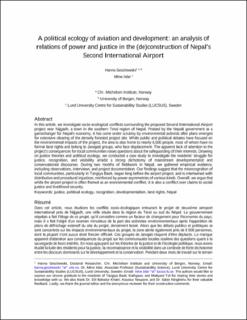A political ecology of aviation and development: an analysis of relations of power and justice in the (de)construction of Nepal's Second International Airport
| dc.contributor.author | Geschewski, Hanna | |
| dc.contributor.author | Islar, Mine | |
| dc.date.accessioned | 2023-02-28T13:24:13Z | |
| dc.date.available | 2023-02-28T13:24:13Z | |
| dc.date.created | 2022-02-02T16:58:46Z | |
| dc.date.issued | 2022 | |
| dc.identifier.issn | 1073-0451 | |
| dc.identifier.uri | https://hdl.handle.net/11250/3054711 | |
| dc.description.abstract | In this article, we investigate socio-ecological conflicts surrounding the proposed Second International Airport project near Nijgadh, a town in the southern Terai region of Nepal. Praised by the Nepali government as a gamechanger for Nepal's economy, it has come under scrutiny by environmental activists after plans emerged for extensive clearing of the densely forested project site. While public and political debates have focused on the environmental impacts of the project, the area is also home to nearly 8,000 people, most of whom have no formal land rights and belong to Janajati groups, who face displacement. The apparent lack of attention to the project's consequences for local communities raises questions about the safeguarding of their interests. Drawing on justice theories and political ecology, we conducted a case study to investigate the residents' struggle for justice, recognition, and visibility amidst a strong dichotomy of mainstream developmentalist and conservationist discourses. During two months of fieldwork in Nepal, we gathered empirical evidence, including observations, interviews, and project documentation. Our findings suggest that the misrecognition of local communities, particularly in Tangiya Basti, began long before the airport project, and is intertwined with distributive and procedural injustices, reinforced by power asymmetries of various kinds. Overall, we argue that while the airport project is often framed as an environmental conflict, it is also a conflict over claims to social justice and livelihood security. | en_US |
| dc.language.iso | eng | en_US |
| dc.publisher | University of Arizona Libraries | en_US |
| dc.rights | Navngivelse 4.0 Internasjonal | * |
| dc.rights.uri | http://creativecommons.org/licenses/by/4.0/deed.no | * |
| dc.subject | Miljørettferdighet | en_US |
| dc.subject | Environmental justice | en_US |
| dc.subject | Nepal | en_US |
| dc.subject | Nepal | en_US |
| dc.subject | Politisk økologi | en_US |
| dc.subject | Political ecology | en_US |
| dc.subject | Anerkjennelse | en_US |
| dc.subject | Recognition | en_US |
| dc.title | A political ecology of aviation and development: an analysis of relations of power and justice in the (de)construction of Nepal's Second International Airport | en_US |
| dc.type | Journal article | en_US |
| dc.type | Peer reviewed | en_US |
| dc.description.version | publishedVersion | en_US |
| dc.rights.holder | Copyright 2022 The Author(s) | en_US |
| cristin.ispublished | true | |
| cristin.fulltext | original | |
| cristin.qualitycode | 1 | |
| dc.identifier.doi | 10.2458/jpe.2304 | |
| dc.identifier.cristin | 1997121 | |
| dc.source.journal | Journal of political ecology | en_US |
| dc.source.pagenumber | 51-75 | en_US |
| dc.identifier.citation | Journal of political ecology. 2022, 29 (1), 51-75. | en_US |
| dc.source.volume | 29 | en_US |
| dc.source.issue | 1 | en_US |
Tilhørende fil(er)
Denne innførselen finnes i følgende samling(er)
-
Department of Geography [634]
-
Registrations from Cristin [9791]

